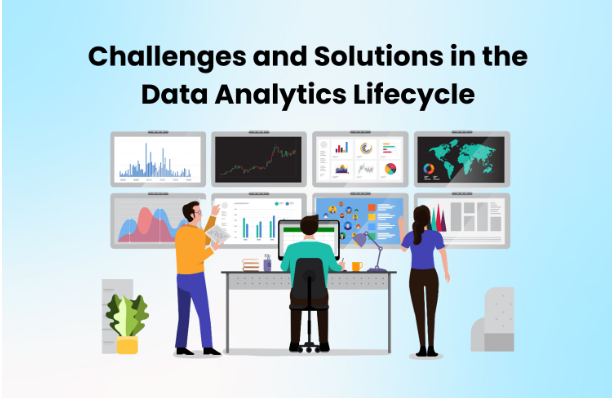Due to digitalization in the modern era, companies generate a large amount of data. Thus, the Data Analytics Lifecycle is an irreversible need of the hour. Every company has its unique processes and requirements, but there are universal best practices that can help any Data Analytics team work efficiently.
Understanding Data Analytics Courses and utilizing them helps build a data-driven culture in your organization. Visualising challenges in Data Analytics and their solutions is expected to commence the process. This blog will cover the major challenges in data analytics lifecycle and the methods to overcome them.
Interpretation of Data Analytics Lifecycle
The Data Analytics Lifecycle includes producing, collecting, processing, using and analyzing data to meet corporate objectives. It provides a systematic way to develop data into useful information that helps organizational or project goals. It also offers guidance and strategies for extracting the information and keeping it moving for corporate objectives.
Data experts use the Data Analytics Lifecycle to go forward or backwards with Data Analytics. They can decide whether to continue with the current research process or abandon it based on the new information. The Data Analytics Lifecycle guides them through this intense process.
Challenges in Data Analytics
Below is the comprehensive list of challenges faced by organizations:
Collecting meaningful data
There’s data for every part of the business, which can be quite overwhelming. The numerous data from different channels make it difficult for employees to pinpoint and extract critical insights. Instead, they end up analyzing the existing and readily available data, which adds no value to the business.
Quality of data collected
The most dangerous aspect of Data Analytics is incorrect data. The output data can be reliable only if the input quality is not flawed or incorrect. Data flaws can be caused by errors made during data entry or disparity in data.
Building a data culture
A data-driven company emerges because of the organization’s culture, not the technologies used. Though top-level employees understand the importance of Data Analysis, they do not give their employees the desired support. This creates disparity and constant pressure between employees, which leads to major Data Analytics challenges.
Data Visualization
Data must be visually presented in graphs or charts to be understood and impactful. While these tools are incredibly fruitful, building them manually is a menace. Strong data systems enable report building at the click of a button. Everyone will have access to important information they need in an appealing format.
Data Security
Unprotected data sources can become easy entry points for malicious invaders. Security of your organization’s data is a necessity and one of the biggest challenges. Organizations tend to overlook the potential risks that enormous amounts of data collected enable.
Solutions for the Challenges
Given below are the solutions to the said challenges as above:
Data Literacy
It can ease most challenges, ranging from collecting data to producing meaningful output. Once the employees understand the data, they will determine which are vital for your business. Basic training programs or hiring a Data Analyst who knows the industry would help add value to the company.
Centralized Data Hub
Organizations should focus on creating extensive data hubs. These hubs would help employees access information from specific locations, free up time spent on data collection, and compare data from across networks.
Successful Data Culture
The world would not change if a person changed. Creating a culture that understands and supports data must be a collective effort. Awareness of the employees to make Data Analysis successful at every level helps them upgrade themselves.
Data Visualization Tools
Various visualization tools, such as Power BI, Tableau, and Google Data Studio, make the learning process easy and provide a wide range of tools. These tools have drag-and-drop features that also help connect to various data sources. They also come with intuitive graphs and charts, thus allowing you to visualize data.
Data Safety
Business data analytics should address security issues and data breaches. Hiring cybersecurity professionals can largely help guard data. Encrypting data with secured credentials and conducting employee training programs also enable data safety. Viewing or editing data securely would provide a safer environment.
Conclusion
Being aware of the challenges in the Data Analytics Lifecycle makes it easier to deal with them and find appropriate solutions. Understanding the issues faced by businesses and their solutions helps in implementing them more structurally. Note that none of the challenges should hinder the utilization of data’s benefits!
